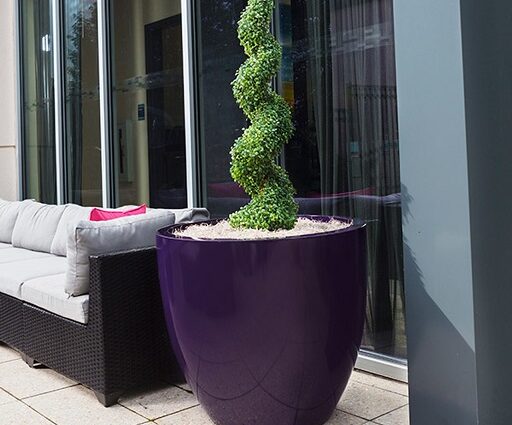There has been a decades-long discussion about the square vs. round planter topic. Gardeners and interior designers have discussed the advantages and disadvantages of each shape at least once in their careers. The discussion always revolves around volume capacity, the quality of life of the plants, and the aesthetic value of each style.
Flower and large plant pots have been traditionally round-shaped for centuries. The main reason is that potter wheels provided a circular movement that allowed artisans to create uniform vessels faster. Production of round clay implements was thus more efficient and cheaper. On the other hand, square shapes require mold creation, which was resource intensive and did not justify the cost.
With the advent of industrialization, the mass production of more efficient shapes was now possible and less resource intensive.
Modernism as an artistic movement took a preeminent role in our culture during the best part of the last century, with buildings shaped in the form of cubes, flanked with grid-like window arrangements, all positioned in perfect rows. It was the sign of a more scientific approach to life in which every aspect of our lives had to be kept in perfect proportions.
This belief also affected gardening and interior design trends. For example, square pots were touted as the latest gardening trend, allowing homeowners to fill them with up to 27% more soil in the same space. They also provided more space for planting more seeds in one container. Moreover, you could fit more modern planters per square foot in wider areas.
Despite these clear advantages, gardeners continued to prefer round planters. But why?
The answer belongs in the realm of physics.
Soil creep is an extremely slow movement that takes place on all granular surfaces, like dirt, compost, or gravel. The movement is caused by the force of gravity, forcing particles to move downwards. This movement is well known in the agriculture industry and is taken into account when planning farmland maintenance strategies.
But the movement also affects potted soil. As gravity pulls dirt and particles downward, it causes a slow vortex effect inside pots. It could indeed take years for a particle to complete a revolution. However, the impact of soil creep is perfectly visible.
Planters with irregular angles or square bottoms will see a slow accumulation of nutrient-rich dirt in the corners as these particles get trapped, which means that the composition of the soil will get progressively poorer as time goes by. Round planters do not have that problem. They allow for an even distribution of nutrients inside the pot and around the roots of your plants as particles travel freely inside the planter.
In terms of aesthetics, as the enthusiasm for more “progressive” trends withered away, general preferences started to gravitate towards more organic shapes. The need for rigid lines and spaces permeated by architectural brutalism slowly gave way to a yearning for softer and more sensuous curves.
For example, commercial spaces today boast an incredible range of round planters made from different materials. Today, visitors and employees favor bold colors and textures, preferring areas that leverage the benefits of a well-kept garden.
Where To Find The Perfect Round Planters
Pots Planters And More offers round planters of all sizes for indoor and outdoor use. Their groundbreaking designs feel like a gust of fresh air with innovative colors and bold shapes made to transform any venue into a vibrant yet relaxing space. Visit their website and look at their incredibly round planter models, or contact them at sales@potsplantersandmore.com for more information about their products and shipping options.
For more information about Modern Rectangular Planter and Planter Boxes Please Visit : Greentec Innovations, Inc.

